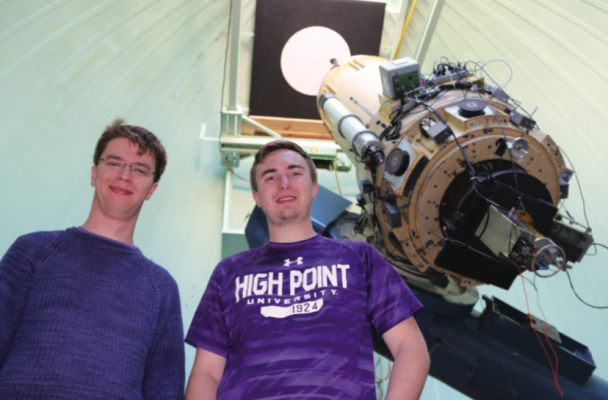HPU students discover eight new pulsating stars

By Devon Wilkinson// Editor-in-cheif
Since the beginning of human existence, we have turned up to the night sky and been fascinated by the endless mystery just beyond our reach. To be mesmerized by stars and space is not uncommon, but what is uncommon is following this fascination nearly 5,000 miles away from home. Astronomy is a lot more than professional stargazing.
Thomas Boudreaux and Kyle Corcoran accompanied Dr. Brad Barlow, on a nine-day exhibition to centered around observational astronomy in Chile.
For the past few years, HPU’s astronomy classes have used a program called SKYNET to conduct their research, a robotic telescope network. The network has achieved the purpose of acting as a valuable resource to study the night sky at any point in time. But according to Corcoran, nothing compares to the “magic” of sitting in front of the telescope lens for yourself collecting new data.
The team did most of their research on the top of Mt. Cerro Tololo, a U.S. National Optical Astronomy Observatory. They spent two days total in La Serena, either to prepare for an observation run or to recover from one.
“There is so much more that goes into making an observation that I think most people would ever realize,” Corcoran says. “You have to prepare your flat fields, open and air out the dome, fill the doer with liquid nitrogen, make sure many software are functioning properly, analyze the CCD’s (the camera) behavior that night, prepare a test field, point the telescope, take field biases, select guiding stars, choose exposure parameters, and determine how long you want to be on an object before you even get to take your first data point.”
This procedure might hurt the heads of most people out there, but Corcoran can’t seem to speak more enthusiastically about the process.
“As if it weren’t cool enough that you are able to learn these techniques and push yourself to observe as many things as you can, you realize that you are doing the same things that so many professional astronomers have done in the same control room.”
The team even found observation logs written by famous astronomers, some created decades ago, written in the very room in which they were making discoveries.
Perhaps one of the most unwieldy aspects of studying astronomy is the hours. Astronomers tend to be on a nocturnal sleeping schedule to adapt to their job’s demands. Boudreaux, understandably, found this a challenge.
“I am the kind of person who goes to bed between 9 p.m. and 10 p.m. every day. Having to stay up not just until midnight, but all the way to 5 a.m. or 6 a.m. (which I didn’t actually manage to do most nights) was not pleasant.” But as views are concerned, “I would rank staying up past midnight, we saw one out of 10 stars and staying up past 2 a.m., we saw 11 out of 10 stars.”
Their effort did not go without reward. The team made the discovery of eight new pulsating stars.
“There’s no feeling quite like discovering something new and realizing for that moment of time you might be the only being in the entire universe to possess that bit of knowledge.”
Barlow says, “watching their own excitement while observing continually reignites my own passion for astronomy and astrophysics.”
Both Boudreaux and Corcoran are expecting to graduate May of 2019, and the passion they have in common is leading them in the same direction. They both plan on applying to fellowships and graduate programs in astrophysics over the course of this semester to hopefully attend once they graduate.
“I think I speak for Thomas when I say that we both wanted to be a part of something that would build our research group up even more. This was HPU’s fourth trip to Chile, and to be a part of something that would not only add to the accomplishments of past trips and the scientific community but also help further generations of our research group to get the same experience is nothing short of amazing.” Fortunately, for HPU students out there who share a similar interest in astronomy, talk to Dr. Barlow, take an astronomy class and maybe accompany the future team of inspiring astronomers to Chile to conduct research.